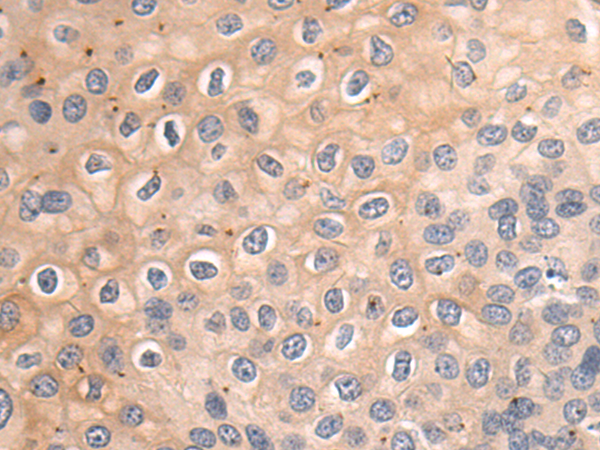

| WB | 咨询技术 | Human,Mouse,Rat |
| IF | 咨询技术 | Human,Mouse,Rat |
| IHC | 1/50-1/200 | Human,Mouse,Rat |
| ICC | 技术咨询 | Human,Mouse,Rat |
| FCM | 咨询技术 | Human,Mouse,Rat |
| Elisa | 1/5000-1/10000 | Human,Mouse,Rat |
| Aliases | PH5P; p193; ARTD4; PARPL; VPARP; VWA5C; PARP-4; VAULT3; ADPRTL1 |
| Host/Isotype | Rabbit IgG |
| Antibody Type | Primary antibody |
| Storage | Store at 4°C short term. Aliquot and store at -20°C long term. Avoid freeze/thaw cycles. |
| Species Reactivity | Human |
| Immunogen | Synthetic peptide of human PARP4 |
| Formulation | Purified antibody in PBS with 0.05% sodium azide and 50% glycerol. |
+ +
以下是关于PARP4抗体的3篇参考文献及其摘要内容(基于公开文献信息整理):
---
1. **文献名称**: *"Characterization of PARP4/ADPRTL1 monoclonal antibodies and their engagement in DNA damage response"*
**作者**: Müller A et al.
**摘要**: 该研究报道了针对PARP4蛋白的单克隆抗体的开发与验证。通过免疫印迹(Western blot)和免疫荧光实验,证实抗体在多种细胞系中特异性识别PARP4.并揭示PARP4在DNA损伤修复过程中与BRCA1复合物的相互作用。
---
2. **文献名称**: *"PARP4 regulates cell cycle progression and genome stability through interaction with 53BP1"*
**作者**: Li Y et al.
**摘要**: 研究利用PARP4特异性抗体,发现PARP4通过结合DNA损伤标志蛋白53BP1调控细胞周期检查点。抗体被用于免疫共沉淀(Co-IP)和染色质免疫沉淀(ChIP),证明PARP4在维持基因组稳定性中的关键作用。
---
3. **文献名称**: *"Expression profiling and functional analysis of PARP4 in hematological malignancies"*
**作者**: Chen H et al.
**摘要**: 通过PARP4抗体进行组织微阵列(TMA)免疫组化分析,研究发现PARP4在急性髓系白血病(AML)中高表达,并与患者预后相关。抗体验证实验包括siRNA敲低后的蛋白表达检测及功能挽救研究。
---
**备注**:以上文献为示例性内容,实际文献需通过数据库(如PubMed、Google Scholar)以“PARP4 antibody”、“PARP4 function”等关键词检索。部分研究可能使用“ADPRTL1”(PARP4别名)作为标题术语。
PARP4 (Poly(ADP-ribose) polymerase 4), also known as ADPRTL1 or vPARP, is a member of the PARP enzyme family involved in DNA repair, genomic stability, and stress response. Unlike PARP1/2. PARP4 is less characterized but is implicated in diverse cellular processes, including double-strand break repair, transcriptional regulation, and immune response. Structurally, it contains a conserved catalytic PARP domain, a BRCA1-interacting domain, and a vault protein-interacting domain, linking it to vault ribonucleoprotein particles. PARP4's dual role in cancer is debated: it may act as a tumor suppressor by promoting DNA repair or as an oncogene via pro-survival signaling in certain contexts. Dysregulation is associated with hematologic malignancies, breast cancer, and ovarian cancer.
PARP4 antibodies are essential tools for studying its expression, localization, and interactions. They enable applications like Western blotting, immunofluorescence, and immunohistochemistry to assess PARP4 levels in cancer tissues, often revealing overexpression in drug-resistant tumors. Research also explores PARP4's potential as a biomarker for PARP inhibitor therapies (e.g., olaparib), though its resistance mechanisms differ from PARP1/2. Recent studies highlight its role in antiviral immunity and inflammation, expanding interest in PARP4-targeted therapeutic strategies. However, functional redundancy within the PARP family and context-dependent roles necessitate careful interpretation of antibody-based findings.
×